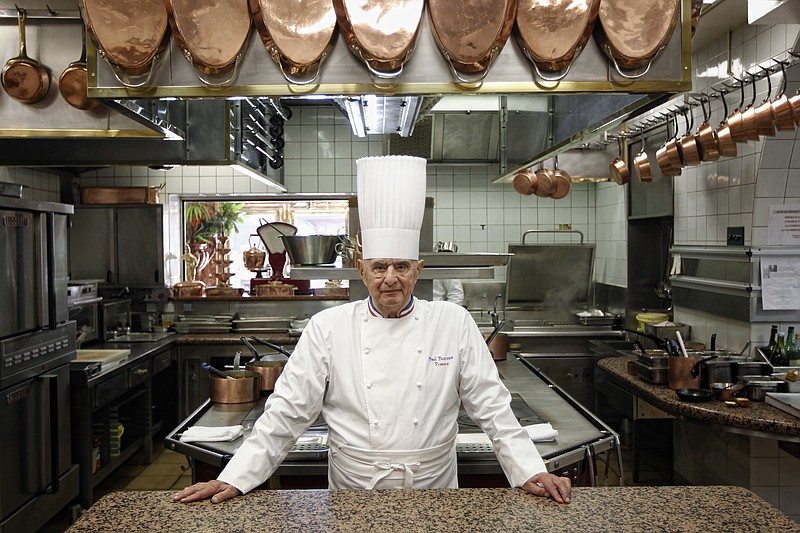PARIS (AP) - Paul Bocuse, the master chef who defined French cuisine for more than half a century and put it on tables around the world, a man who raised the profile of top chefs from invisible kitchen artists to international celebrities, has died at 91, French officials announced.
Often referred to as the "pope of French cuisine," Bocuse was a tireless pioneer, the first chef to blend the art of cooking with savvy business tactics - branding his cuisine and his image to create an empire of restaurants around the globe. His imposing physical stature and his larger-than-life personality matched his bold dreams and his far-flung accomplishments.
Bocuse died Saturday at Collonges-au-Mont-d'or, the place where he was born and had his restaurant, French President Emmanuel Macron said in a statement.
"French gastronomy loses a mythical figure. The chefs cry in their kitchens, at the Elysee (presidential palace) and everywhere in France," Macron said.
Interior Minister Gerard Collomb tweeted "Mister Paul was France. Simplicity and generosity. Excellence and art de vivre."
Bocuse, who underwent a triple heart bypass in 2005, had also been suffering from Parkinson's disease.
Bocuse's temple to French gastronomy, L'Auberge du Pont de Collonges, outside the city of Lyon in southeastern France, has held three stars - without interruption - since 1965 in the Michelin guide, the bible of gastronomes.
As early as 1982, Bocuse opened a restaurant in the France Pavilion in Walt Disney World's Epcot Center in Orlando, Florida, headed by his son Jerome, also a chef. In recent years, Bocuse even dabbled in fast food with two outlets in his home base of Lyon.
"He has been a leader. He took the cook out of the kitchen," said celebrity French chef Alain Ducasse, speaking at a 2013 gathering to honor Bocuse. More than 100 chefs from around the world traveled to Lyon for the occasion - one of a string of such honors bestowed on Bocuse in recent years.
"Monsieur Paul," as he was known, was placed right in the center of 2013 cover of the newsweekly Le Point that exemplified "The French Genius." Shown in his trademark pose - arms folded over his crisp white apron, a tall chef's hat, or "toque," atop his head - he was winged by Marie Curie, Louis Pasteur and Coco Chanel, among other French luminaries.
While excelling in the business of cooking, Bocuse never flagged in his devotion to his first love, creating a top class, quintessentially French meal. He eschewed the fads and experiments that captivated many other top chefs.
"In cooking, there are those who are rap and those who are concerto," he told the French newsmagazine L'Express before his 2005 biography, adding that he tended toward the concerto.
In traditional cooking like his, he said, there is no room for guess work.
"One must be immutable, unattackable, monumental," he declared.
Born into a family of cooks he dates to the 1700s, Bocuse stood guard over the kitchen of his world-famous restaurant even in retirement, keeping an eye on guests, sometimes greeting them at table.
The red-and-green Auberge by the Saone River, his name boldly set atop the roof, is a temple to Bocuse - who was born there - and to other great chefs. Bocuse waves to arriving guests in a "tromp l'oeuil" painting on an outside wall and peers at them from a large portrait inside the cozy Auberge that once belonged to his parents and remained his home. Renowned chefs, some of whom he worked with, are portrayed in a giant mural.
In a 2011 interview with the Associated Press, Bocuse said he slept in the room where he was born above the dining rooms. "But I changed the sheets," he added with characteristic wry humor.
Born on Feb. 11, 1926, Bocuse entered his first apprenticeship at 16. He worked at the famed La Mere Brazier in Lyon, then spent eight years with one of his culinary idols, Fernand Point, whose cooking was a precursor to France's nouvelle cuisine movement, with lighter sauces and lightly cooked fresh vegetables.
Bocuse's career in the kitchen traversed the ages. He went from apprenticeships and cooking "brigades," as kitchen teams are known, when stoves were coal-fired and chefs also served as scullery maids, to the ultra-modern kitchen of his Auberge.
"There was rigor," Bocuse told the AP. "(At La Mere Brazier) you had to wake up early and milk the cows, feed the pigs, do the laundry and cook . It was a very tough school of hard knocks."
"Today, the profession has changed enormously. There's no more coal. You push a button and you have heat," he said.
Bocuse adapted seamlessly to the changing times, making his mark with a first coveted Michelin star in 1958, a second in 1960 and a third in 1965. Since then, his cooking has been defined by superlatives.
In 1989, Bocuse was named Cook of the Century by Gault & Millau, a noted guidebook. In 2011, the Culinary Institute of America named him Chef of the Century, opening a restaurant for students in his name. He maintained a special pride, however, in the blue, white and red stripes on his chef's collar holding a large medal, attesting to his selection in 1961 as a "Meilleur Ouvrier de France," a sought-after distinction for chefs and other artisans.
The gastronomic offerings at Bocuse's L'Auberge du Pont de Collonges are rooted in the French culinary tradition: simple, authentic food that was "identifiable" in its nature.
Emblematic of that was a crock of truffle soup topped with a golden bubble of pastry he created in 1975 for then-French President Valery Giscard d'Estaing, which is served to this day. Another classic is fricassee of Bresse chicken - from France's Bresse region, which is famed for its poultry - served in cream with morilles, a spring mushroom.
And his favorite ingredient? Butter.
"(It's a) magical product," he said during a visit to the Culinary Institute of America. "Nothing replaces butter."

